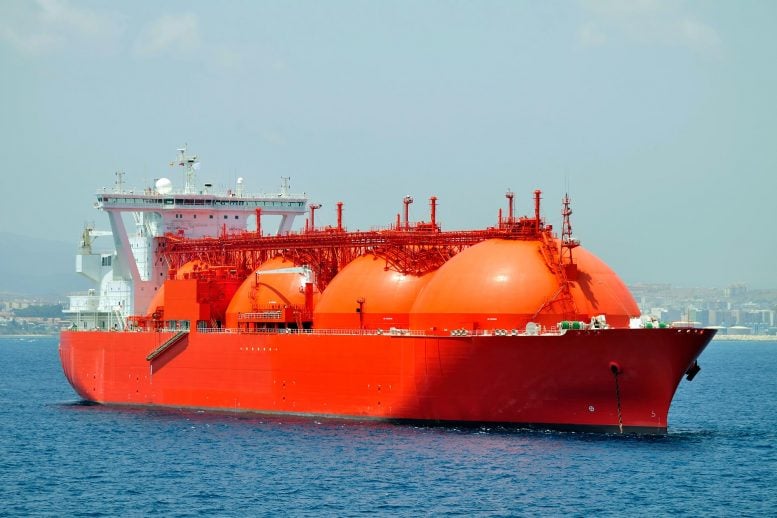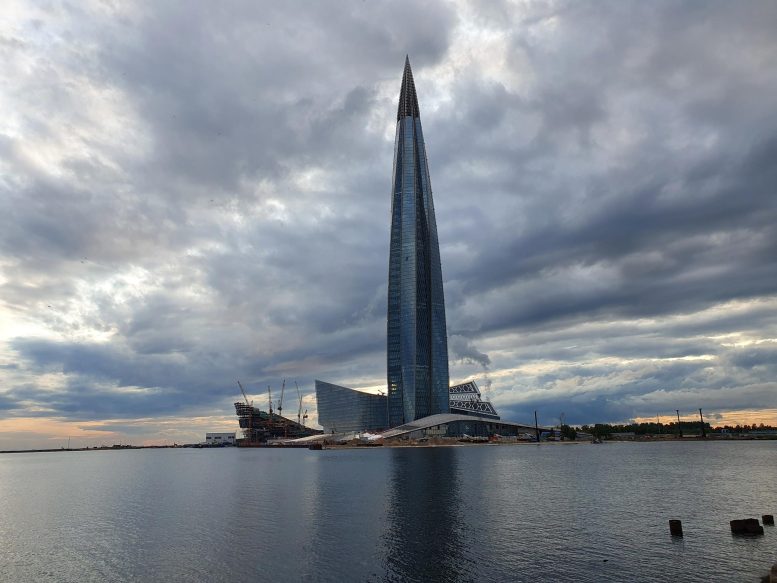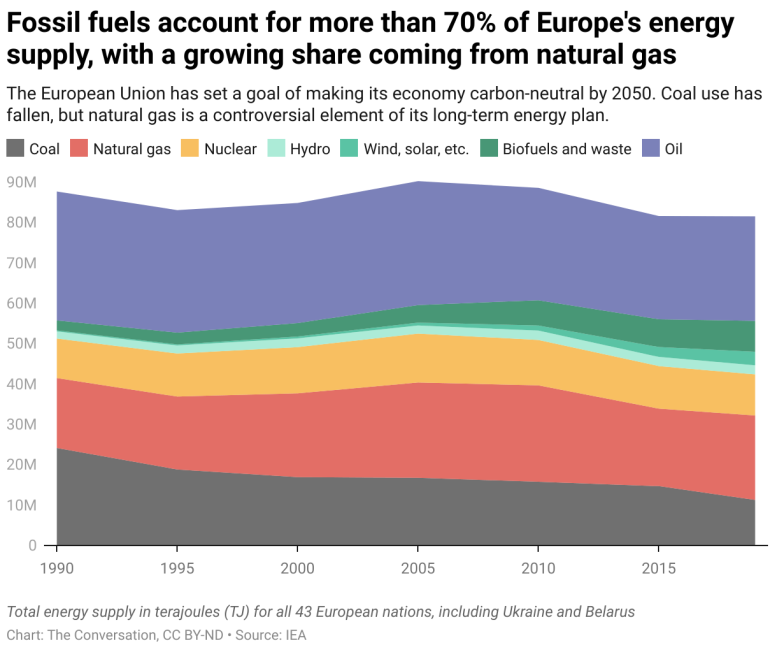
The prospect of conflict between Russia and NATO countries over Ukraine has raised fears of an energy crisis in Europe. Russia provides nearly half of Europe’s natural gas, and some leaders worry that Moscow could tighten the flow if hostilities break out. To weaken Russia’s leverage, the Biden administration is working to secure additional gas shipments to Europe from other sources. Global energy policy expert Amy Myers Jaffe explains how much gas is available and what’s involved in rerouting it.
How dependent is Europe on natural gas, and who are its main suppliers?
Natural gas represents about one-fifth of all primary energy used across Europe. It accounts for about 20% of electric power generation and also is used for heating and industrial processes.
Russia is the largest supplier of natural gas to Europe, sending about 40% of the continent’s supplies shipped by pipeline. The next-largest suppliers via pipeline are Norway (22%), Algeria (18%) and Azerbaijan 9%. Europe also receives natural gas that is liquefied and delivered by ship.
In recent months, European imports of liquefied natural gas, or LNG, from the U.S. and elsewhere reached record levels at around 400 million cubic meters per day. To put that in perspective, a single LNG cargo ship can hold roughly 125,000-175,000 cubic meters of natural gas – enough energy to warm 17 million British homes for one winter day.
The EU and the US are jointly committed to Europe’s energy security 🇪🇺🇺🇸
The US is our largest LNG supplier.
We are collaborating on the supply of additional volumes of natural gas.
Read the joint statement by @POTUS and President @vonderleyen ↓
— European Commission (@EU_Commission) January 28, 2022
What are the biggest constraints for exporters on sending more gas to Europe?
LNG is made by cooling natural gas to minus 260 degrees Fahrenheit (minus 162 degrees Celsius), which reduces its volume by a factor of more than 600. Natural gas is piped to a port, processed in a liquefaction plant, and then loaded into specialized insulated, temperature-controlled tankers for shipment by sea.
To receive LNG, an offloading port must have a regasification plant that converts the LNG back to a gaseous form so it can be sent by pipeline to end users. Both liquefaction plants and regasification plants cost billions of dollars and take multiple years to build.
Following a similar crisis in 2009, when a financial conflict with Ukraine prompted Russia to suspend gas shipments for 20 days, Europe substantially expanded its number of regasification facilities to 29. There is still currently space in European regasification receiving terminals to import more LNG, and plenty of storage space to hold imported supply virtually indefinitely. But many of the world’s top suppliers are maxed-out, with little capacity to produce and liquefy more natural gas than they are already moving.
The global LNG market has some flexibility. About two-thirds of all LNG is sold under firm, long-term contracts with fixed destinations. Some major contract holders like South Korea, Japan and China and their suppliers are willing to redirect cargoes to Europe if a further cutback in Russian exports creates a worsening supply crisis.
A look at the U.S.‘s emergence as a major natural gas exporter, focusing on the company Freeport LNG.
Have suppliers rerouted shipments this way before?
The main example occurred in 2011 when a tsunami triggered a meltdown and radiation release at Japan’s Fukushima Daiichi nuclear plant. Japan shut down all of its nuclear plants to assess whether they were prepared for similar disasters. LNG suppliers diverted gas shipments to Japan to help it weather the immediate crisis.
Today, analysts say that producers or LNG importers may be able to redirect cargoes that could offset about 10%-15% of any shortfall. Still, such shifts would likely be at premium prices, leaving European consumers with an even steeper bill than they face now.
Will increased U.S. LNG shipments to Europe drive up prices for U.S. consumers?
Existing U.S. LNG export facilities have been running at full capacity for several months. About half of U.S. LNG shipments in December 2021 were destined for Europe, spurred by rising prices in European markets. Previously, a larger share of U.S. LNG exports were sailing to China, where drought-related constraints on hydroelectric power had created a surge in demand for natural gas.
In other words, U.S. sellers have been able to supply more gas to Europe by diverting export cargoes, rather than by selling gas that would otherwise have been used domestically. In my view, if U.S. natural gas prices rise in the coming weeks, winter weather is likely to be a bigger driver than LNG exports.
Wouldn’t Russia harm its own economy by cutting off gas exports to Europe and losing those revenues?
In recent years, Russia has structured its federal budget in a manner that has allowed it to stash away US$630 billion in foreign exchange reserves – cash held by the central bank in other currencies for discretionary use, much like individual savings accounts. Russian leaders can use these funds to weather any new sanctions or unexpected changes in the price of oil.
For example, last year, the Kremlin based its spending on a conservatively low break-even oil price estimate of $45 per barrel, giving itself some latitude. Ultimately, 2021 oil prices averaged $71 a barrel, providing a sizable budgetary windfall.
Through this fiscal strategy, Russian President Vladimir Putin has amassed a war chest to withstand any new round of sanctions, or even the complete loss of natural gas export revenues from Europe for a period of time.

Still, any Russian move to cut off gas exports to Europe might have longer-term consequences. Putin may have hoped that his saber-rattling about natural gas, and the high prices it has triggered, would convince Europeans that Russian gas is vital and can’t be easily replaced with renewable energy. But ironically, this tactic may already have created a lasting distaste that fast-tracks Europe’s pivot to offshore wind, Euro-North African hydrogen hubs, and U.S. LNG.
Gazprom, the Russian firm with the largest gas export footprint in Europe, might also find itself adrift in a sea of lawsuits and high penalty charges for breaking its contractual commitments in the wake of a cutoff. That in turn could affect the Russian people, who also rely on Gazprom’s solvency for their winter fuel for heating.
Putin may be willing to bet that an energy pricing crisis in Europe will sow popular discontent, scotch the energy transition and help Russia win concessions on NATO’s positioning of troops and missiles. But there is little evidence that Europe will react that way. While Europe’s shift to renewables will take time, it will still be bad news in the long run for Russia, which has 1,688 trillion cubic feet of natural gas reserves left to be exploited for as much as 100 years of supply.
Written by Amy Myers Jaffe, Research professor, Fletcher School of Law and Diplomacy, Tufts University
This article was first published in The Conversation.![]()
Never miss a breakthrough: Join the SciTechDaily newsletter.

4 Comments
Very helpful explanation. And one that I can understand tho challenged in econ. lol Thank you.
It would be to expensive for Europe to buy.
Hi…in case you didn’t know,Russia no longer has full access to the entirety of the FX reserves. The US and its allies froze their FX reserves based on ongoing sanctions( estimated to be about 45-50% of total FX reserves),so Russia is not able to turn off the gas taps without enduring some Bigly pain.
That is the whole idea, sanctioned Russia so the US will supply gas to Europe at twice or triple the price plus LNG is not environementally friendly. Indirectly the US is benefiting from this crises by making billions in revenue.